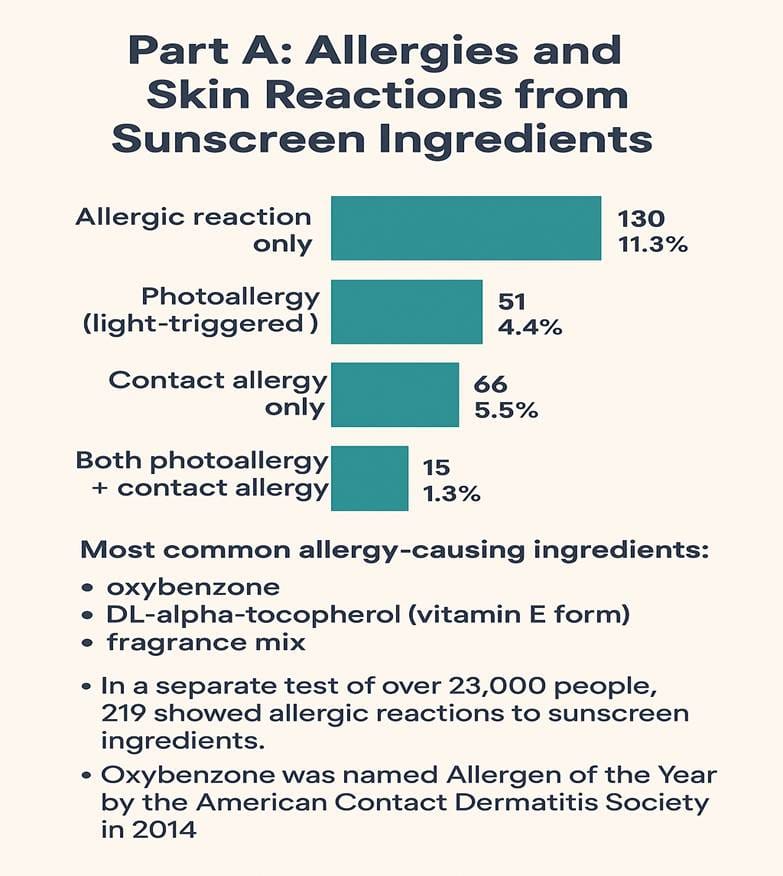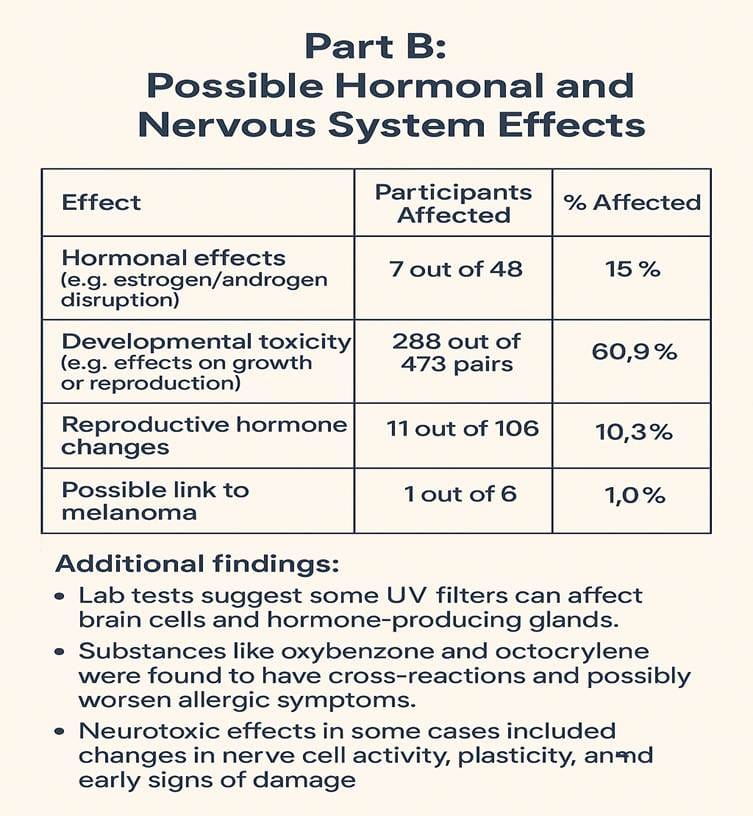The Side Effects of Sunscreen!!

Most of us are aware that sunscreen helps protect our skin from the sun's harmful effects. But how does it actually work, and is it completely safe? Scientists have been studying and developing UV filters, which are ingredients responsible for shielding our skin from the sun’s harmful rays [1]. These filters are effective in preventing sunburns, but some have raised concerns about possible health risks [1].
To explore these concerns, we will be assessing the findings from the paper titled “Potential Systemic Toxicity of UV Filters in Sunscreen: A Review” [1].
What Are UV Filters?
UV filters are the active ingredients in sunscreen that protect your skin from ultraviolet (UV) radiation, the kind of sunlight that can damage your skin cells [1]. There are three types of UV rays:
· UVA rays: Cause skin ageing and inflammation, and can suppress the immune system. They also damage DNA, proteins, and fat in the skin [1].
· UVB rays: Cause sunburns and are strongly linked to skin cancer [1].
· UVC rays: The most dangerous type, but thankfully, they are completely absorbed by the ozone layer and do not reach the Earth’s surface, thus not affecting us [1].
Sunscreens are designed to protect us from UVA and UVB rays, the types of radiation to which we are exposed every day [1].
Factors Influencing UV Exposure
How much UV radiation you’re exposed to does not only depend on how sunny it is, but also depends on
· How long you spend outside [1].
· Whether you wear sunscreen or protective clothing (long-sleeved pants and t-shirts) [1].
· Where you live. People closer to the equator, where UV rays are the strongest [1].
People living near the equator in countries such as Brazil, the Philippines, or Ecuador receive significantly higher doses of UV radiation than those in temperate regions, thereby increasing their risk of skin damage [1].
Types of UV Filters
UV filters were first used in beach sunscreens, then spread to outdoor sports products [1]. Now you can find them in all sorts of cosmetic products such as moisturisers, foundation, lip balms, and even hair products [1].
There are two main types of UV filters:
· Mineral (inorganic) filters, like zinc oxide and titanium dioxide [1]. These sit on top of your skin and reflect UV rays like tiny mirrors [1].
· Chemical (organic) filters, like oxybenzone and avobenzone [1]. These absorb UV rays and turn them into heat [1].
Many sunscreens combine both types to provide ‘broad-spectrum protection’ across UVA and UVB [1].
There are around 55 UV filters approved worldwide, but different countries have varying rules [1]. For example, Europe allows more advanced UVA filters than the U.S. due to slower regulatory updates [1].
Are UV Filters Safe?

While UV filters reduce sunburns and signs of ageing, some chemical ingredients, especially organic filters such as oxybenzone, have raised questions about potential side effects.
Here’s what the research knows:
· Mineral filters like zinc oxide are not absorbed through the skin [1]. They are generally considered safe, though some people may have mild skin reactions [1].
· Chemical filters like oxybenzone can be absorbed through the skin [1]. Some studies have found small traces in blood and urine [1]. Sometimes these levels have occurred far above the U.S. FDA threshold for requiring further safety testing [1].
One study found that applying UV filters containing oxybenzone every two hours as directed can lead to levels in the bloodstream that reach more than 500 times higher than what the FDA considers safe without further data [1]. This does not mean it’s dangerous, but it does raise red flags and suggests further research needs to be conducted [1].
Some studies suggest certain chemical filters may interfere with hormones (known as endocrine disruption) [1]. Endocrine disruption can lead to a range of health issues, such as reproductive issues, developmental abnormalities, and increased risks of certain cancers and metabolic disorders. For clarification, the paper does not say sunscreen causes these health risks.
However, other studies show no clear harmful effects [1]. Thus, the evidence for now is mixed and needs further testing [1].
Potential Side Effects and Reactions
Some people may experience side effects from sunscreen ingredients, especially with repeated or long-term use [1]. These include
· Allergic reactions and photoallergies (reactions triggered by sunlight exposure) have been reported with some chemical filters [1].
· Potential hormone disruption, based on lab and animal tests. However, human evidence remains limited [1].
· Environmental concerns: Some filters, like oxybenzone, have been shown to damage marine life, coral reefs, and ecosystems, which has led to places like Hawaii banning certain ingredients [1].
Studies have also found possible links between UV filters. These include
· Hormonal imbalances [1].
· Allergic reactions [1].
· Increased oxidative stress [1].
· Makes skin more sensitive to sunlight [1].
· Skin cell damage [1].
· Neurotoxicity [1].
For example, one lab study found that chemical filters could affect oestrogen, androgen, and thyroid hormones and even impact brain cells and behaviour [1]. Two filters in particular, dibenzoylmethane and benzophenone, stood out for being especially concerning due to their chemical structure [1].

Fig.1. Infographic showing the data from research studies displaying the side effects, reactions, and conditions found in sunscreen ingredients.
What the Research Shows
A review of over 300 scientific papers (narrowed to 43 key studies) looked at how UV filters behave in and on the body [1]. They found that
· Some UV filters can enter the body and show up in urine [1].
· Certain filters may act like hormones in lab tests [1].
· Reactions like contact allergies or light-triggered skin rashes are more common than people realise, especially with oxybenzone [1].
· In one Canadian study, 99 out of 160 people had allergic or photoallergic reactions to common sunscreen ingredients [1]. The most frequent allergen was oxybenzone [1].
Animal studies have also reported reproductive issues and other developmental problems, especially when animals were exposed to UV filters during pregnancy and development [1]. This appears to be caused by the chemicals leading to endocrine disruptions [1].

Fig.2. Infographic showing results from studies that display possible effects sunscreen ingredients may have on the hormonal and nervous system.
Should You Still Use Sunscreen?
According to this study, despite the concerns, the known benefits of sunscreen outweigh the potential risks for most people [1].
Sunscreen helps prevent:
· Sunburn [1].
· Long-term skin ageing [1].
· UV damage that could lead to cancer [1].
While there is still no hard proof that sunscreen directly prevents melanoma (the deadliest type of skin cancer) [1]. This is mostly because running such a long-term human trial would be difficult [1].
To stay protected, the paper recommends:
· Apply enough sunscreen (the recommended amount should be stated on the label of the bottle) [1].
· Reapply about every 2 hours, or after swimming or sweating [1].
· Combine sunscreen with other protection such as hats, clothing, and shade [1].
Striving to Improve Sunscreen
Researchers and public health agencies are working to:
· Create safer and more effective UV filters [1].
· Improve safety testing, especially for long-term effects [1].
· Have sunscreen regulations be consistent around the world [1].
· Improve public education on sunscreen use and risks [1].
Conclusion
Sunscreen is one of the most effective ways to protect your skin from the sun. While no product is perfect, it is still important to understand both the benefits and risks of using sunscreen.
If you want to stay informed about our latest articles, make sure to subscribe to the Bare Science newsletter. Become a member to receive early access and other exclusive perks.
References
Reference paper “Potential Systemic Toxicity of UV Filters in Sunscreen: A Review”
